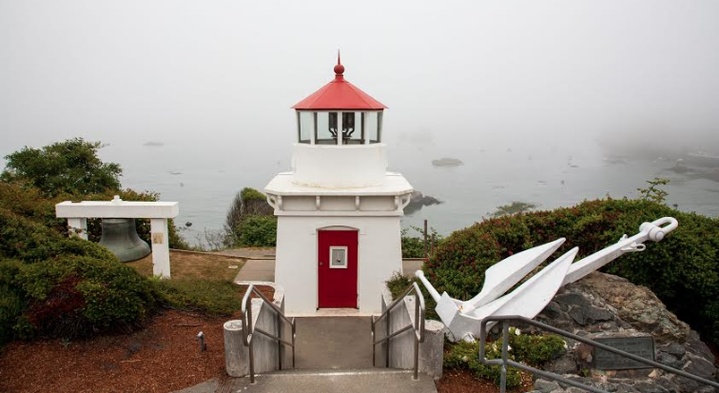
Matt Filar | Union
Municipal leaders and the civic club have agreed in principle to raise $40,000-$50,000 to move the Trinidad Memorial Lighthouse a few “tens of feet” away from landslide threats.
Leaders hope to complete the move by October, before the rainy season starts.

Civic Club President Dana Hope informed the city council last week that her group could say “yes” to the stopgap financing, to be secured via fundraising that would include online solicitations.
The $40,000-$50,000 in “seed money” is contingent in part, however, on how much more Trinidad’s government can secure in financing from California’s Office of Emergency Services (OES) and FEMA, the Federal Emergency Management Agency.
OES funding is reckoned likely, but FEMA’s response is pending.
The slope that undergirds both the lighthouse and Edwards Street, the thoroughfare that lies just above the structure, need long-term reinforcement. Construction costs range from $100,000 to $1 million, according to a recent engineering report.
The report, based on drill borings, readings from slope inclinometers and aerial and field mapping, was compiled by SHN Consulting Engineers & Geologists, Eureka. City Manager Dan Berman has circulated it to OES, FEMA and the Tsurai Management Team as well as to the civic club.
In support of the club’s putative funding commitment, the city council unanimously approved a motion on an oral vote July 26 to “fast track” the permitting process for moving the lighthouse.
SHN urges the stopgap action to stave off the immediate geological threat. The company’s assessment produced a consensus among city council members and the civic club to move the lighthouse, possibly less than 15 feet.
“We strongly recommend some action be taken prior to the next rainy season. It may not be feasible to complete any slope reinforcement [by October] due to the permitting constraints,” SHN concluded.
Undecided is whether the lighthouse would be moved intact or disassembled for safekeeping.
The issue is whether the top, the cupola, would have to be separated from the foundation and whether the foundation would have to be replaced or rebuilt.
Councilor Jim Baker advised his colleagues, “It would be very difficult to move the lower part of the structure,” which is made of wood.
SHN Engineer Gary Simpson summarized his company’s findings at the city council’s monthly meeting last week.
If the coming winter rains are as heavy and prolonged as those of 2016/2017, which were well above the historical average, both the lighthouse and its foundation could be compromised, Simpson said. There is even a chance the structure could fall over if it isn’t moved promptly.
A tension crack has continued to develop into the current summer dry season, engineers found.
For the next year or two, Edwards Street is in less precarious condition than the lighthouse, but SHN urged construction of a retaining wall to shore up the street after 2019 or so.
The memorial lighthouse stands opposite the intersection of Edwards and Trinity streets, the main junction between the center of the village and the motorway downhill to Trinidad Beach. Traffic flow is hefty, peaking at vacation time.
SHN called attention to the buffer between the head of the landslide and the edge of Edwards Street. That cushion relieves somewhat the immediate risk factor, “as compared to the lighthouse,” the company said. “However, we expect the head of the landslide to continue encroaching toward Edwards Street within the next few years.”
That leads to the question of state and federal funding beyond what the civic club is able to raise to preserve the lighthouse. Berman, the city manager, said the state OES might provide aid under a disaster declaration to counteract the landslide. Edwards Street is a scenic drive with lots of pavement whose condition is affected by persistently unstable ground, exacerbated by inclement weather.
Berman said he awaits FEMA’s response to the engineering study but cautioned that the federal agency usually prefers financing the repair of damage already documented to picking up the uncertain costs of future threats.
Nonetheless, “FEMA is infrastructure-based,” observed Councilor Susan Golledge-Rotwein. She voiced hope the agency might help defray the costs of buttressing Edwards Street if not the lighthouse.
“So far, we’ve spent about $65,000,” Berman said. About half of that was the cost of SHN’s analysis, the rest for ground surface remediation in the wake of last winter’s heavy rains. Council members are anticipating more data from the site, including those from the inclinometers, also called tilt meters, which measure changes in slope angles.
SHN offered a recommendation for follow-on action in the event Trinidad stakeholders decide to return to the lighthouse to its existing site after its temporary relocation. Moving the lighthouse will not arrest the landslide, which is a permanent geological threat.
Soil stabilization measures are only interim fixes and the best and most lasting mitigation measure is the construction of a retaining wall about 160 feet long, with construction costs estimated at $560,000 to $1 million, SHN said in its report to the council.
High expenses would be incurred from the extensive grading and temporary access roads that would have to be built along the edge of Edwards Street to enable heavy construction equipment to enter the site.
# # #
Paul Mann writes for the Mad River Union. Subscribe here.
CLICK TO MANAGE